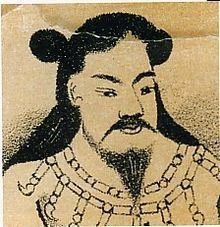Predecessor Annei Died 477 BC Grandparent Emperor Suizei | Successor Kōshō Children Emperor Kōshō | |
 | ||
Reign 510 BC – 477 BC (traditional) Burial Unebi-yama no minami no Masago no tani no e no Misasagi (Nara) Parents Nunasoko Nakatsu hime no mikoto, Emperor Annei Grandchildren Emperor Kōan, Ametarashihiko kunioshihito no mikoto Similar Emperor Suizei, Emperor Annei, Emperor Kōshō, Emperor Kōan, Emperor Jimmu | ||
Emperor Itoku (懿徳天皇, Itoku-tennō); also known as Ooyamatohikosukitomo no Mikoto; was the fourth emperor of Japan according to the traditional order of succession.
No firm dates can be assigned to this emperor's life, but he is conventionally considered to have reigned from 510 BC to 476 BC.
Legendary narrative
Modern scholars have come to question the existence of at least the first nine emperors; Itoku's descendant, Emperor Sujin is the first that many agree might have actually existed. The name Itoku-tennō was assigned to him posthumously by later generations.
Itoku is regarded by historians as a "legendary emperor" and there is a paucity of information about him. There is insufficient material available for further verification and study. The reign of Emperor Kinmei (c. 509 – 571 AD), the 29th emperor, is the first for which contemporary historiography is able to assign verifiable dates; However, the conventionally accepted names and dates of the early emperors were not to be confirmed as "traditional" until the reign of Emperor Kanmu (737–806), the 50th sovereign of the Yamato dynasty.
In the Kojiki and Nihon Shoki only his name and genealogy were recorded. He is believed to be the son of Emperor Annei; and his mother is believed to have been Nunasoko-Nakatsu-hime, who was the granddaughter of Kotoshiro-Nushi-no-kami. The Japanese have traditionally accepted this sovereign's historical existence, and an Imperial misasagi or tomb for Itoku is currently maintained; however, no extant contemporary records have been discovered that confirm a view that this historical figure actually reigned. He is considered to have been the third of eight emperors without specific legends associated with them, also known as the "eight undocumented monarchs" (欠史八代, Kesshi-hachidai).
Jien records that Itoku was the second or third son of Emperor Annei, but the surviving documents provide no basis for speculating why the elder brother or brothers were passed over. He is traditionally believed to have ruled from the palace of Migario-no-miya at Karu in what would come to be known as Yamato Province.
His posthumous name literally means "benign virtue". It is undisputed that this identification is Chinese in form and Buddhist in implication, which suggests that the name must have been regularized centuries after the lifetime ascribed to Itoku, possibly during the time in which legends about the origins of the Yamato dynasty were compiled as the chronicles known today as the Kojiki.
The actual site of his grave is not known. This emperor is venerated at a memorial Shinto shrine (misasagi) in Nara.
The Imperial Household Agency designates this location as Annei's mausoleum. It is formally named Unebi-yama no minami no Masago no tani no e no misasagi.
